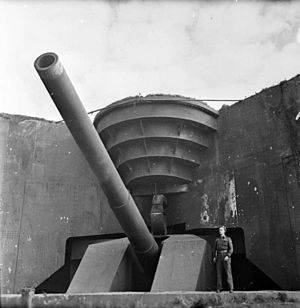Operation Undergo
| Operation Undergo | |||||||
|---|---|---|---|---|---|---|---|
| Part of Western Front, World War II | |||||||
 A British soldier poses next to the recently captured German 380mm gun Todt Battery at Cap Gris Nez. |
|||||||
|
|||||||
| Belligerents | |||||||
|
|
|
||||||
| Commanders and leaders | |||||||
|
|
|
||||||
| Strength | |||||||
| 7,500 in Calais | |||||||
| Casualties and losses | |||||||
| approx. 260 | 9,128 captured, including "about 1,600" from Cape Gris Nez | ||||||
Operation Undergo was the 3rd Canadian Infantry Division's operation to take the fortified French port of Calais in September 1944. A subsidiary operation was executed to silence and capture the heavy batteries at Cap Gris Nez, which threatened the sea approaches to Boulogne. The operation was part of the Allied effort to capture the Channel ports, following the breakout from Normandy.
The assault on Calais followed the formula used at Boulogne: seal off the town, soften up the defenders with artillery, aerial and naval bombardments and infantry assaults supported by armour, including flame-throwing tanks, and coordinated artillery rolling barrages. In the event, although the city had been declared a fortress (German: Festung), when pressed, its second-rate garrison needed little persuasion to surrender. This reluctance to fight to the end was repeated at Cap Gris Nez.
The 7th and 8th Canadian Infantry Brigades started the main attack from the south west of Calais and cleared the outer defences on the city's southern and western sides. The 8th Brigade were then transferred to the eastern side and the inner defensive lines were attacked from both sides. The Germans called for a truce which, after some misunderstanding, lead to an unconditional surrender of the garrison. In the meantime, the 9th Brigade took the heavy batteries on Cap Gris Nez.
Across northern France, the German army was in headlong retreat after their military disaster at Falaise and the allied breakout. There were no reserve defences to fall back on, as Hitler had forbidden their construction. The rapid allied advances into eastern France and across Belgium, however, had stretched the allied supply lines and the acquisition of new ports through which to import materiel was a priority for the 1st Canadian Army.
Bernard Montgomery had assessed that he needed the Channel ports of Le Havre, Dieppe, Boulogne, Calais and Dunkirk to supply his 21st Army Group and he repeatedly pressed the Canadian army commander, Henry Crerar, to capture these ports. Most of them had been designated as "Fortresses", to be fortified and held by their garrisons for as long as was possible. The garrison troops, however, were not first class. The Calais commander, Oberstleutnant Ludwig Schroeder, commented that his garrison was "mere rubbish", consisting of 7500 sailors, airmen and soldiers of whom only 2500 were available for use as infantry. Morale of the isolated troops was low, they were susceptible to Allied propaganda; many were "Volksdeutsche" (ethnic Germans born in foreign countries), and "Hiwis" (foreign volunteers). A report of the post battle interrogations of prisoners described the garrison thus: "Army personnel were old, ill, and lacked both the will to fight and to resist interrogation; naval personnel were old and were not adjusted to land warfare; only the air force A.A. gunners showed any sign of good morale-and were also the only youthful element of the whole garrison." On the other hand, after his capture Schroeder was assessed by his interrogators as a "mediocre and accidental" leader, who only became commander of the area because he happened to be present.
...
Wikipedia
